TAF Dance オンラインクラス 毎週火曜 20:30-22:00
打ダンス オンラインクラス 毎月第2日曜 16:00-17:30
どちらのクラスもアーカイブにて受講・復習可
両クラス受講の場合、割引あり
TAFクラスは課題添削つき
お申し込み・お問合せはInstagramのDMにてご連絡ください。
Traditional AsianFusion(TAF) dance: TAF Dance Instagram
DA-打-DANCE: DA-打-DANCE Instagram
About “Da Dance”
打ダンスとは
“Da Dance” is a new genre of dance created by Natsumi Suzuki, who is originally from Hachioji, Tokyo, known for the silk fabric industry. It is incorporating a lot of Japanese gestures/movements, traditional Japanese and various Asian folk dances.
「打ダンス」とは国内外で活動する舞踊家 Natsumi Suzukiによって創られた日本やアジアの民族舞踏や所作を取り入れた新しいジャンルのダンス。
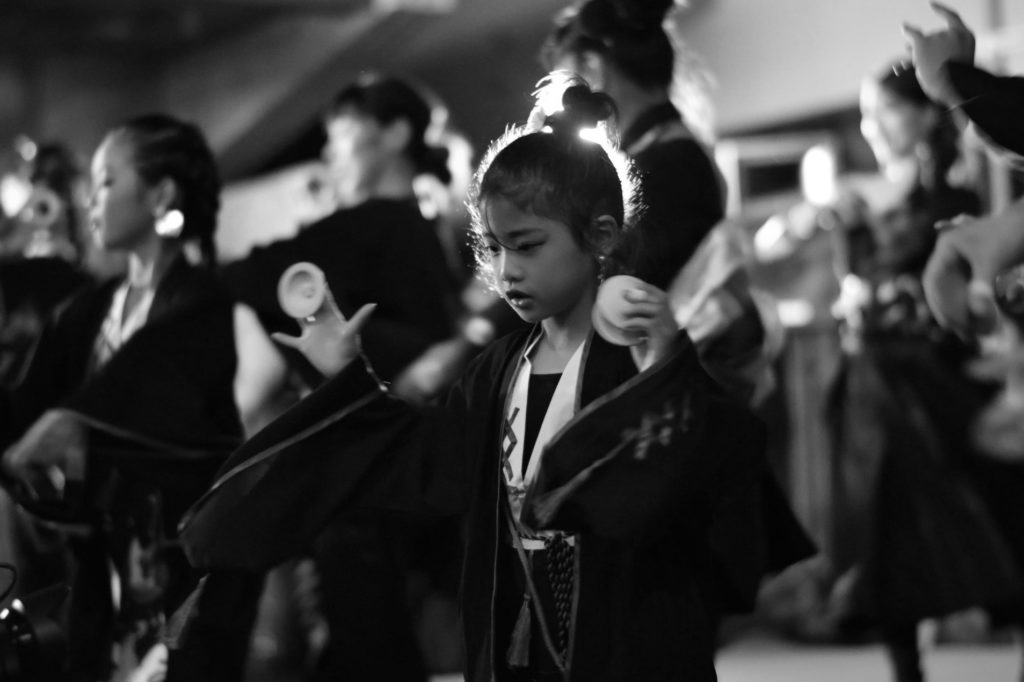
打ダンスキッズダンサーズ
打ダンス教室一覧
http://natsumisuzuki.com/?p=7490
For the naming, the first “ Da ” of “Da Dance” is also written as “打” in Japanese Kanji, symbolizing the meaning of hit, strike, beat etc. in English.This is coming from the hitting sound of drums, step beating the ground, using folklore instruments called Surigane (Japanese traditional percussion made by metal) and Wooden Finger Cymbals (one-by-one hand made by local professional wood craftsman in Hachioji specially for this dance) etc.
「Da Dance(ダ・ダンス)」の“打-Da”をあえて漢字表記としているのは、これが英語で Hit, Strike, Beatなどの意味を象徴し、太鼓を打つ音、地面を打ち鳴らすようなステップ、 摺鉦(金属製の民族打楽器)や木製フィンガーシンバル(八王子の地元職人がこのダンス のために特別に一つ一つ手作りしたもの)などを用いることに由来している。
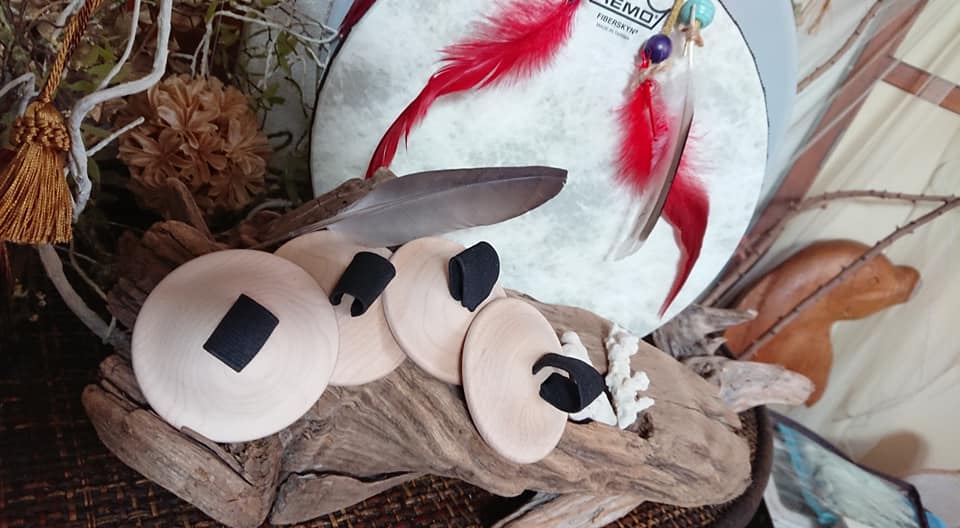
写真提供: Kayo Hanano
In this dance, not only dancing with the formation facing front for the stage performance, it can be danced in a circle, just like Japanese Bon Odori (Japanese traditional “Bon” Festival dance) as well.
このダンスは、舞台を想定して正面を定めたフォーメーションだけでなく、日本の盆踊りのように輪になって踊ることもできる。
Besides, improvisation can also be added, and in which case, the mechanism is that the ones who clangs the Surigane makes decision for the next coming step and inform other dancers by the rhythm first.
また、大勢で踊る群舞であるにも関わらず即興を加えることができるのがこのダンスの最大の特徴である。摺鉦を鳴らす者が次に来るステップを決定し、リズムで他の踊り手たちに知らせる方法で行われる。
This method was also designed by Natsumi. She was inspired by American Tribal StyleⓇ, an improvisational group dance style, as well as traditional Japanese festival music called “Ohayashi,” in which improvisation is signaled by blowing a whistle for the next song. These influences lead her to establish an original style by incorporating Surigane for the improvisation, called “Surigane Method”*¹ in Da Dance.
この方法はNatsumiによって考案されたが、きっかけとして、群舞即興で踊られるAmerican Tribal Style®に感銘を受けたこと、そして本人が慣れ親しんだ日本の伝統的な祭音楽である「お囃子(祭囃子)」の笛の合図で次の演目を知らせるという即興法から、打ダンスにも同様に即興を取り入れることができないかと考え、「摺鉦形式」(注1)と呼ぶひとつのオリジナルスタイルを確立するに至った。

Until today, Natsumi has worked on the dance performance and the choreography for the audience. However, in the wake of her father having become a wheelchair life due to illness, she became more aware of reality that having physical difficulty is incapable to move or dance hard enough, and also came to stand with more wide range of aspects with social situation such as aging society, that dancers as occupation must retire much earlier than others, and all these above eventually motivated her to create the Da Dance.
これまでショーで観客に見せるダンスや振り付けを中心に行ってきたNatsumiだが、自身の父親が病気で車椅子生活になったことを受け、身体に困難があるために激しい動きやダンスができないという現実を認識、他の職種に比べダンサーという職業は引退が早いことや高齢化社会など複数の社会的な視点にも立ったことが、この打ダンスを創る一つの動機となった。
Da Dance was created to be participated and enjoyed by anyone rather than watching, just like Bon Odori (Bon dance).
打ダンスは、ただ見て楽しむというよりは盆踊りのように参加して楽しむものとして創 案された。
・Anyone who has insured/physical difficulty or who is not confident with dancing(or steps) can also participate within each of their physical ability range, i.e. moving only upper body, playing instruments only, take the role of cueing with Surigane for the next song/improvisation.
怪我や身体に何かしらの困難を抱えている、あるいはダンスやステップに自信の無い人でも個々の身体能力の範囲内(度合いによって)参加することが可能。
・Playing instruments is also effective for brain activation.
楽器を演奏することは、脳の活性化にも役立つ。
・It is also exciting to think of what song/steps will come next in the improvisation, feeling the tension and irritation like playing games which is also effective for brain activation as well as concentration required.
また、即興演奏において次に来る音楽やステップを考えることが緊張感や刺激を生み、ゲーム感覚で楽しむことができる。集中力も必要となるため、これも脳の活性化に繋がる。

Da Dance Lesson
・The steps in Da Dance is consist of three basic standards: “not too easy”, “not too hard”, “incorporating coolness”. This is the reason why this is easy and joinable exercise/dance for anyone without forcing difficulty to the body.
打ダンスで使用されるステップは、「簡単過ぎず」「難し過ぎず」「恰好良さも取り入れ る」という3つの柱を基準としている。これが身体に無理な負担をかけることなく、老若男女、誰でも楽しく運動・ダンスができる理由である。
As her underlying thoughts, Natsumi intends to make this as a trigger to develop interest in Asia and to share as much Japanese spiritual culture as possible to the people around the the world throughout Da Dance.
打ダンスを通じ、世界の人々に日本の精神文化を伝えること、アジアに対する興味を持ってもらうことを目指している。
打ダンス Da Dance is a registered trademark
2020年6月 打ダンス 商標登録取得
*1 Surigane Method
In Da Dance, the person in the role of Surigane will not dance but give the rhythm as cue and inform others what song/step comes next, which is different one another method from American Tribal Style®.
(注1) 摺鉦方式打ダンスでは、摺鉦役は踊らずにリズムを合図として次の踊りやステップを皆に知らせるというAmerican Tribal Style®と異なる方式がとられている。

Natsumi Suzuki
Japanese dancer/choreographer/artist, performing around the world based in San Francisco. Born in Fukuoka Prefecture (Kyushu District), grown up in Hachiōji City, Tokyo. After from early childhood experiences with classical ballet, hip-hop, jazz etc., she obtained the Artist Visa and moved to the United States in 2007, has learnt Tribal Fusion Belly Dance.
She also is a choreographer, and the director which currently working on her original styled dance, “Traditional Asian Fusion dance” (TAF).
すずき なつみ
米国サンフランシスコを拠点に世界各地で活動する日本人舞踏家。福岡県生まれ、東京都八王子育ち。幼少期よりクラシックバレエ・ヒップホップ・ジャズなどのダンスを経た後、アーティストビザを取得し2007年に渡米、トライバルフュージョンベリー ダンスを学んだ。また、彼女は振付家でもあり、現在取り組んでいる自身のオリジナ ルスタイルによる「Traditional Asian Fusion dance (TAF)/トラディショナルアジアン・フュージョンダンス」の ディレクターとしても活躍している。
Translated by Hiromi Araya
打ダンス教室一覧
http://natsumisuzuki.com/?p=7490
上記でご近所に打ダンス教室がない方は打ダンスインストラクターを目指していただくことも可能です。
インストラクター資格を取得されると、ご自身のお教室やチームを作って、お祭りやイベント、各地支部での合同パフォーマンスなどに参加していただけます。
お祭り、イベントのオファーはこちらのページからメッセージをください。地方、遠方、海外からでも大丈夫です。
インスタグラム @dadancetokyo (こちらは返信が遅くなる場合がございます。その際はTAFダンスカンパニーマネージャー @mizue.k115 のアカウントまでご連絡ください。)
Katahada-Nugi
(One shoulder baring clothing style)
※日本語は下に続きます。
Let me explain about this Kimono styled fashion.
At the unveiling of “Da Dance”, I proposed the fashion to take off one sleeve of kimono. Actually, this is not anything to intend to look sexy.
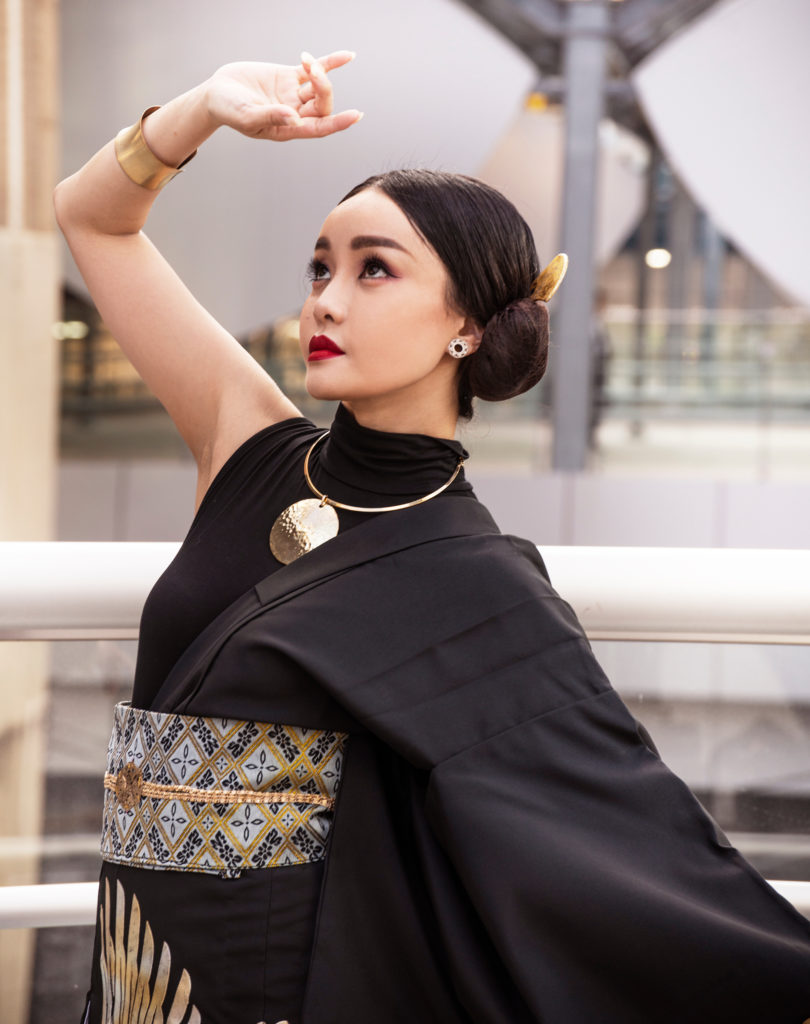
In Japan from old days, when people have some work to do, they used to take off a side of dominant sleeve to ease working. There from, it has been said “to bare the one shoulder off for (someone/something)” when you help others.
There are both dancers and instrument players in Da Dance. This is how and why this dance is for anyone to join, and to entertain not only themselves but each other. I have been supported from a lot of people throughout my entire life along with dancing until I finally create this dance. It was something I could never be accomplished on my own. For this reason, I decided to incorporate this concept into our costumes from the idea that “everyone support each other (to bare one shoulder off)”.
*Katahada…..One side of shoulder showing skin (especially on the better side of arm/hand)
*Nugi…..taking clothes off
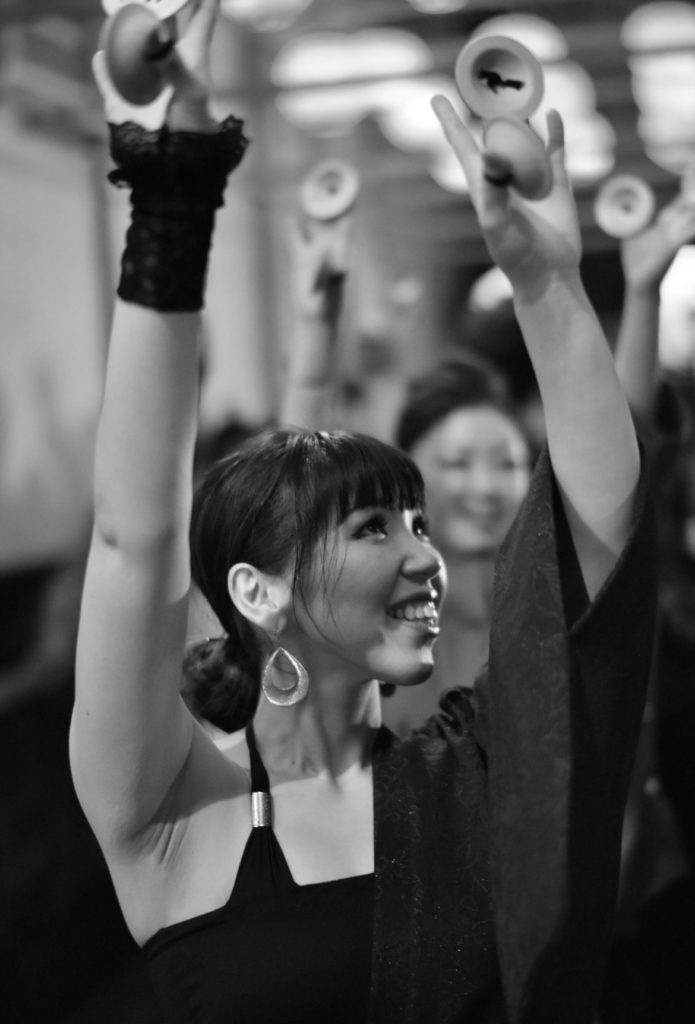
Hachiman Kagura
【片肌脱ぎ】
この着物ファッションについて語らせてください。今回、初の『打ダンス』お披露目にあたり、私は着物の片袖を脱ぐファッションを提案しました。これはセクシーに見せたい訳ではありません。
昔から日本ではひと仕事する際、利き腕の袖を作業しやすいように脱いでおりました。そこから、他人に力を貸すことを「~のために片肌脱ぐ(一肌脱ぐ)」と言うようになりました。 打ダンスは、群舞で踊る人達、演奏者達がいます。一人ではなく、皆で楽しむためのダンスです。
私はこのダンスを創るまでの長いダンサー生活の中で、たくさんの人たちに支えられてきました。打ダンス創作は、一人では絶対に成し得ることができなかった事です。 そういった経緯を踏まえ、「皆がお互いを助け合う(片肌脱ぐ)」という想いを込めて今回の衣装を【片肌脱ぎ】とした次第です。
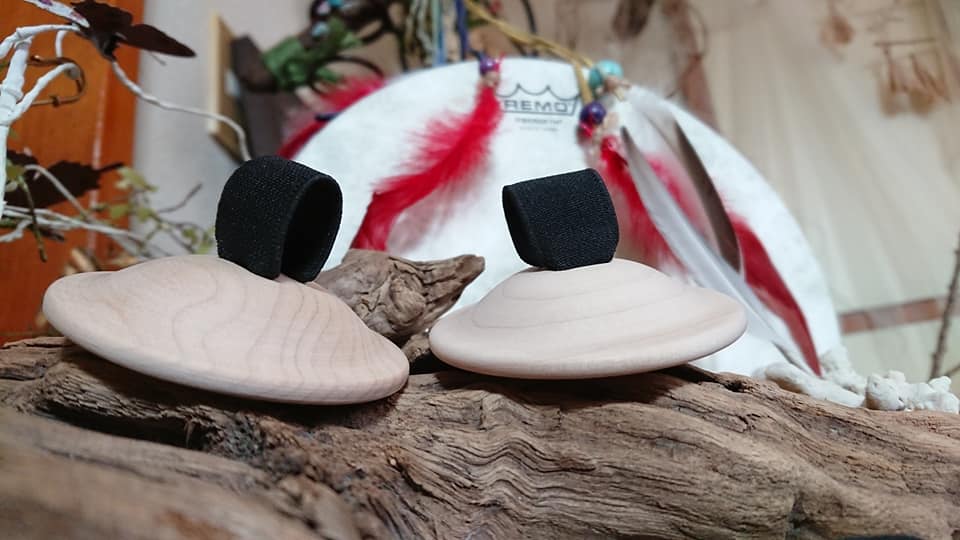
写真提供: Kayo Hanano
